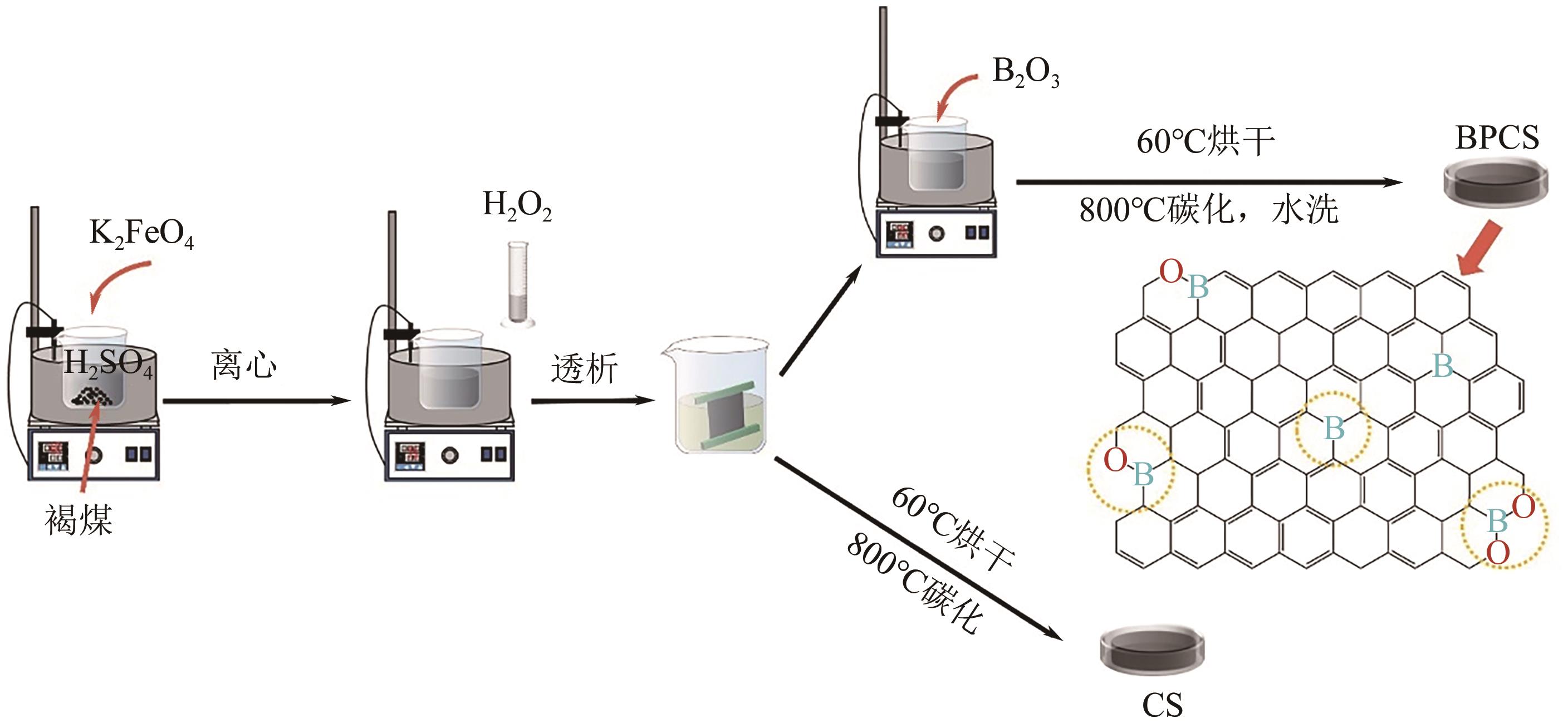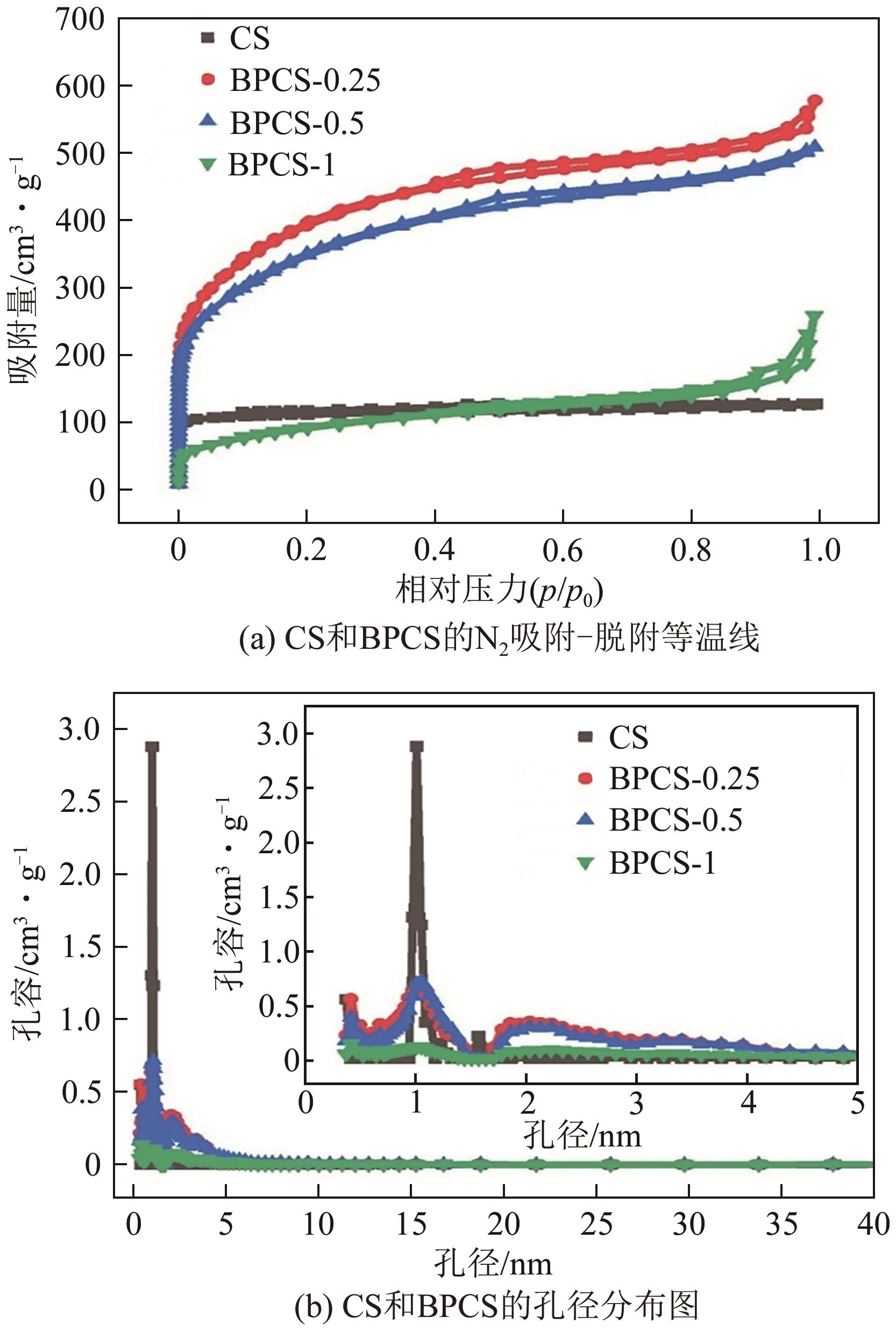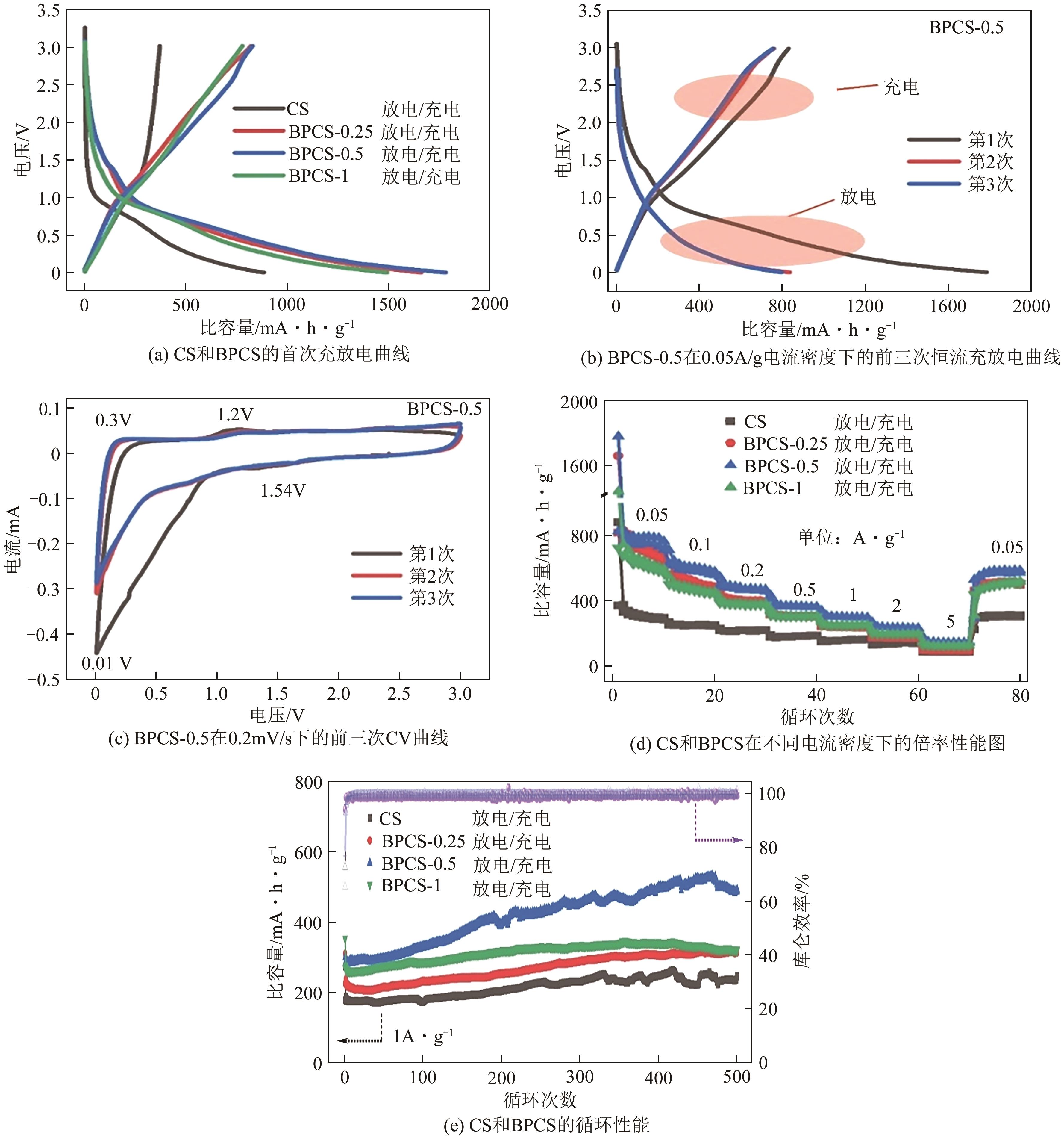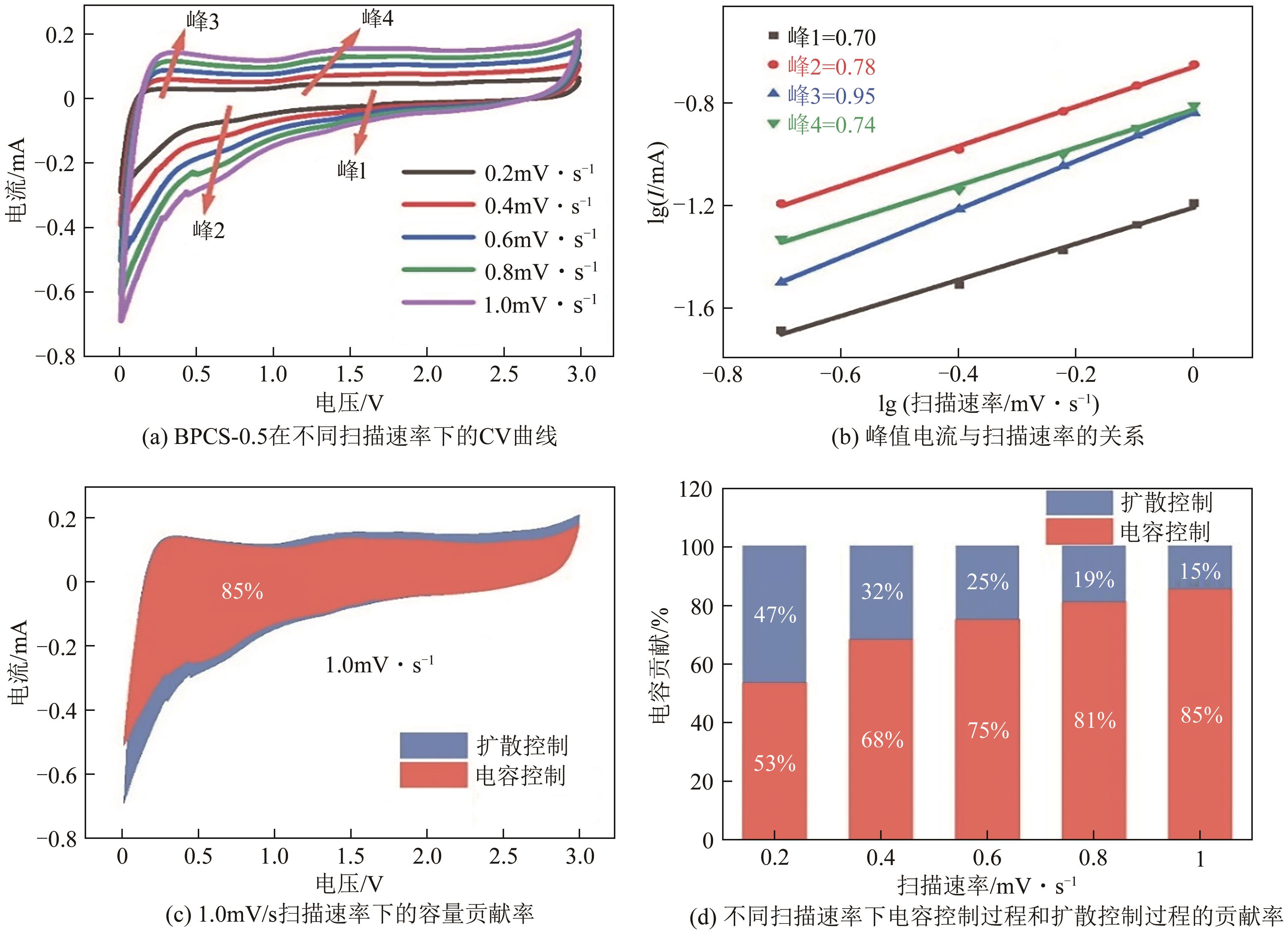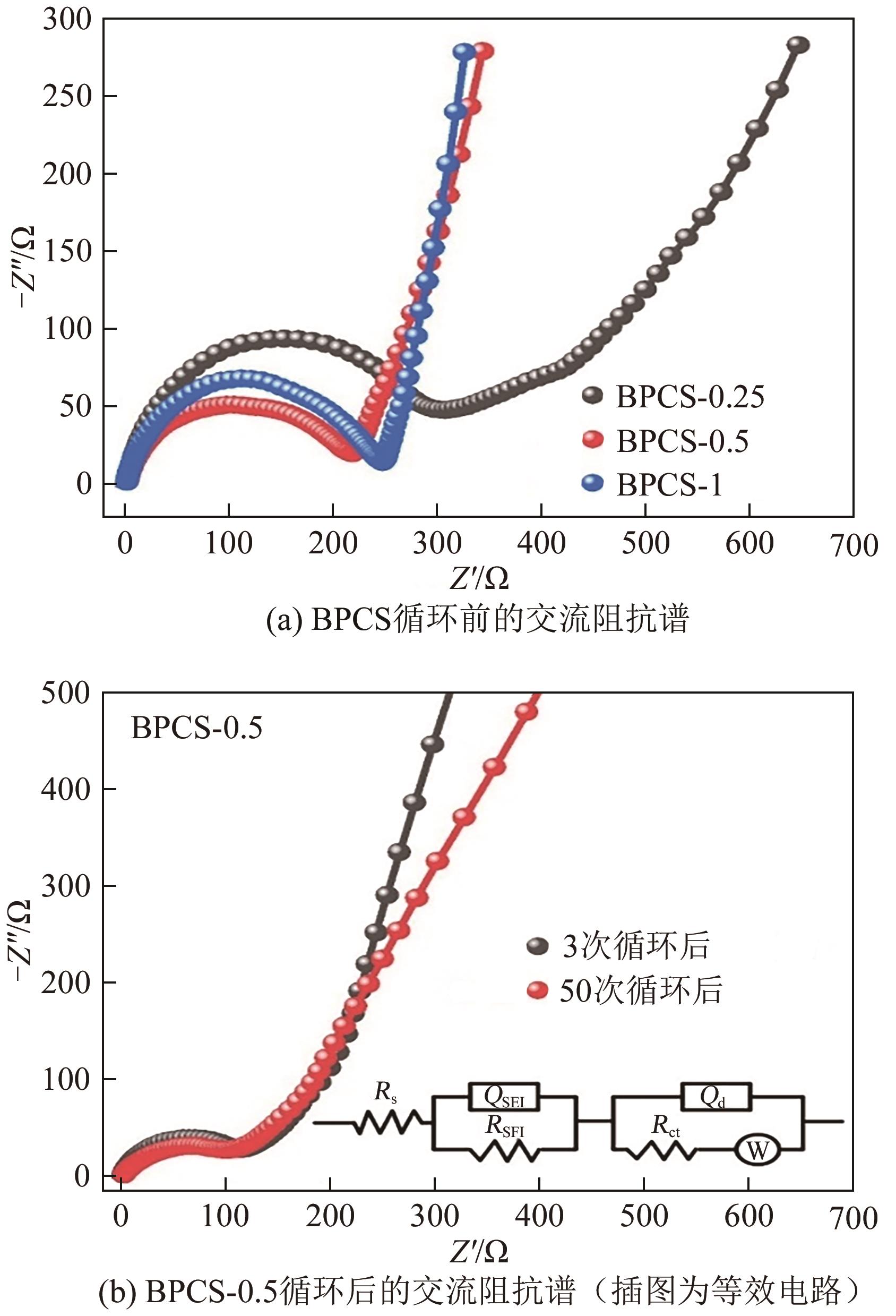化工进展 ›› 2024, Vol. 43 ›› Issue (6): 3209-3220.DOI: 10.16085/j.issn.1000-6613.2023-0753
• 材料科学与技术 • 上一篇
B掺杂多孔碳纳米片的制备及其储锂性能
孙悦1( ), 邢宝林1,2(
), 邢宝林1,2( ), 张耀杰1, 冯来宏3, 曾会会1, 蒋振东1, 徐冰1, 贾建波1, 张传祥1,2, 谌伦建1, 张越1, 张文豪1
), 张耀杰1, 冯来宏3, 曾会会1, 蒋振东1, 徐冰1, 贾建波1, 张传祥1,2, 谌伦建1, 张越1, 张文豪1
- 1.河南理工大学化学化工学院,河南 焦作 454000
2.煤炭安全生产与清洁高效利用省部共建协同创新中心,河南 焦作 454000
3.华能煤炭技术研究有限公司,北京 100071
-
收稿日期:2023-05-08修回日期:2023-08-11出版日期:2024-06-15发布日期:2024-07-02 -
通讯作者:邢宝林 -
作者简介:孙悦(1992—),女,博士研究生,研究方向为矿产资源加工利用。E-mail:1509047307@qq.com。 -
基金资助:国家自然科学基金(52274261);国家级大学生创新创业训练计划(202110460011)
Preparation of B-doped porous carbon nanosheets and their lithium storage performance
SUN Yue1( ), XING Baolin1,2(
), XING Baolin1,2( ), ZHANG Yaojie1, FENG Laihong3, ZENG Huihui1, JIANG Zhendong1, XU Bing1, JIA Jianbo1, ZHANG Chuanxiang1,2, CHEN Lunjian1, ZHANG Yue1, ZHANG Wenhao1
), ZHANG Yaojie1, FENG Laihong3, ZENG Huihui1, JIANG Zhendong1, XU Bing1, JIA Jianbo1, ZHANG Chuanxiang1,2, CHEN Lunjian1, ZHANG Yue1, ZHANG Wenhao1
- 1.College of Chemistry and Chemical Engineering, Henan Polytechnic University, Jiaozuo 454000, Henan, China
2.State Collaborative Innovation Center of Coal Work Safety and Clean-efficiency Utilization, Jiaozuo 454000, Henan, China
3.Huaneng Coal Technology Research Co. , Ltd. , Beijing 100071, China
-
Received:2023-05-08Revised:2023-08-11Online:2024-06-15Published:2024-07-02 -
Contact:XING Baolin
摘要:
负极材料是影响锂离子电池(LIBs)性能的关键因素之一,孔隙结构调控和杂原子掺杂是提高负极材料电化学性能的有效手段。以褐煤为前体,采用化学氧化法制备煤基碳纳米片(CS),再以氧化硼(B2O3)为添加剂,得到B掺杂多孔碳纳米片(BPCS);采用扫描电镜(SEM)、透射电镜(TEM)、X射线衍射(XRD)、拉曼光谱(Raman)、氮气吸附仪、X射线光电子能谱(XPS)等手段对CS和BPCS微观结构和用作锂离子电池负极材料的电化学性能表征与测试。结果表明,B2O3具有模板、造孔、掺杂三重作用,当B2O3用量为0.5g时,BPCS-0.5呈现三维多孔结构,比表面积为1216.20m2/g,总孔容1.027cm3/g,B原子含量为4.20%;BPCS-0.5的多孔结构为离子的存储和传输提供足够的空间和通道,B元素的引入增加了BPCS的表面化学活性,从而增强了储锂性能。BPCS-0.5用作锂离子电池负极材料时,在0.05A/g电流密度下首次可逆容量达826mA·h/g,且在5A/g大电流密度下可逆容量仍有143mA·h/g,循环500次的容量保持率为172%,表明该材料具有较高的储锂容量和优异的循环寿命。
中图分类号:
引用本文
孙悦, 邢宝林, 张耀杰, 冯来宏, 曾会会, 蒋振东, 徐冰, 贾建波, 张传祥, 谌伦建, 张越, 张文豪. B掺杂多孔碳纳米片的制备及其储锂性能[J]. 化工进展, 2024, 43(6): 3209-3220.
SUN Yue, XING Baolin, ZHANG Yaojie, FENG Laihong, ZENG Huihui, JIANG Zhendong, XU Bing, JIA Jianbo, ZHANG Chuanxiang, CHEN Lunjian, ZHANG Yue, ZHANG Wenhao. Preparation of B-doped porous carbon nanosheets and their lithium storage performance[J]. Chemical Industry and Engineering Progress, 2024, 43(6): 3209-3220.
| 样品名称 | 比表面积/m2·g-1 | 总孔容/cm3·g-1 | 微孔孔容/cm3·g-1 | 微孔率/% | 中孔孔容/cm3·g-1 | 中孔率/% | 大孔孔容/cm3·g-1 | 大孔率/% |
|---|---|---|---|---|---|---|---|---|
| CS | 440.78 | 0.316 | 0.292 | 92.40 | 0.055 | 5.53 | 0.007 | 2.21 |
| BPCS-0.25 | 1298.10 | 1.174 | 0.474 | 40.41 | 0.611 | 52.05 | 0.088 | 7.53 |
| BPCS-0.5 | 1216.20 | 1.027 | 0.415 | 40.37 | 0.561 | 54.66 | 0.051 | 4.95 |
| BPCS-1 | 301.04 | 0.451 | 0.087 | 19.31 | 0.222 | 49.33 | 0.141 | 31.35 |
表1 CS和BPCS的比表面积和孔径参数
| 样品名称 | 比表面积/m2·g-1 | 总孔容/cm3·g-1 | 微孔孔容/cm3·g-1 | 微孔率/% | 中孔孔容/cm3·g-1 | 中孔率/% | 大孔孔容/cm3·g-1 | 大孔率/% |
|---|---|---|---|---|---|---|---|---|
| CS | 440.78 | 0.316 | 0.292 | 92.40 | 0.055 | 5.53 | 0.007 | 2.21 |
| BPCS-0.25 | 1298.10 | 1.174 | 0.474 | 40.41 | 0.611 | 52.05 | 0.088 | 7.53 |
| BPCS-0.5 | 1216.20 | 1.027 | 0.415 | 40.37 | 0.561 | 54.66 | 0.051 | 4.95 |
| BPCS-1 | 301.04 | 0.451 | 0.087 | 19.31 | 0.222 | 49.33 | 0.141 | 31.35 |
| 样品名称 | C含量 | O含量 | B含量 | ||||||||
|---|---|---|---|---|---|---|---|---|---|---|---|
| 总含量 | C—B | C | C—O | C | COOH | 总含量 | 总含量 | BC3 | BC2O | BCO2 | |
| CS | 91.11 | — | 79.40 | 12.00 | 5.40 | 3.00 | 7.24 | — | — | — | — |
| BPCS-0.25 | 85.07 | 1.48 | 75.41 | 14.49 | 5.72 | 2.89 | 11.73 | 3.20 | 23.33 | 72.39 | 4.27 |
| BPCS-0.5 | 83.49 | 1.73 | 72.61 | 15.89 | 6.22 | 3.35 | 12.31 | 4.20 | 17.54 | 74.37 | 8.00 |
| BPCS-1 | 77.21 | 2.40 | 71.78 | 16.53 | 5.43 | 3.84 | 16.25 | 6.54 | 14.87 | 80.23 | 4.89 |
表2 CS和BPCS官能团的相对含量
| 样品名称 | C含量 | O含量 | B含量 | ||||||||
|---|---|---|---|---|---|---|---|---|---|---|---|
| 总含量 | C—B | C | C—O | C | COOH | 总含量 | 总含量 | BC3 | BC2O | BCO2 | |
| CS | 91.11 | — | 79.40 | 12.00 | 5.40 | 3.00 | 7.24 | — | — | — | — |
| BPCS-0.25 | 85.07 | 1.48 | 75.41 | 14.49 | 5.72 | 2.89 | 11.73 | 3.20 | 23.33 | 72.39 | 4.27 |
| BPCS-0.5 | 83.49 | 1.73 | 72.61 | 15.89 | 6.22 | 3.35 | 12.31 | 4.20 | 17.54 | 74.37 | 8.00 |
| BPCS-1 | 77.21 | 2.40 | 71.78 | 16.53 | 5.43 | 3.84 | 16.25 | 6.54 | 14.87 | 80.23 | 4.89 |
| 样品 | 不同电流密度下的第10次充电比容量/mA·h·g-1 | |||||||
|---|---|---|---|---|---|---|---|---|
| 0.05A·g-1 | 0.1A·g-1 | 0.2A·g-1 | 0.5A·g-1 | 1A·g-1 | 2A·g-1 | 5A·g-1 | 0.05A·g-1 | |
| CS | 285 | 246 | 218 | 184 | 164 | 143 | 88 | 312 |
| BPCS-0.25 | 641 | 471 | 390 | 302 | 234 | 171 | 94 | 498 |
| BPCS-0.5 | 715 | 559 | 457 | 360 | 296 | 231 | 143 | 571 |
| BPCS-1 | 570 | 443 | 375 | 304 | 250 | 195 | 124 | 507 |
表3 CS和BPCS在不同电流密度下第10次的可逆比容量
| 样品 | 不同电流密度下的第10次充电比容量/mA·h·g-1 | |||||||
|---|---|---|---|---|---|---|---|---|
| 0.05A·g-1 | 0.1A·g-1 | 0.2A·g-1 | 0.5A·g-1 | 1A·g-1 | 2A·g-1 | 5A·g-1 | 0.05A·g-1 | |
| CS | 285 | 246 | 218 | 184 | 164 | 143 | 88 | 312 |
| BPCS-0.25 | 641 | 471 | 390 | 302 | 234 | 171 | 94 | 498 |
| BPCS-0.5 | 715 | 559 | 457 | 360 | 296 | 231 | 143 | 571 |
| BPCS-1 | 570 | 443 | 375 | 304 | 250 | 195 | 124 | 507 |
| 序号 | 样品 | 比容量/mA·h·g-1,电流密度/A·g-1 | 比容量/mA·h·g-1,循环次数,电流密度/A·g-1 | 参考文献 |
|---|---|---|---|---|
| 1 | 0.5BN-CQD | 130,3 | 485,100,0.1 | [ |
| 2 | B-CNT | 345,0.1 | 261,500,0.5 | [ |
| 3 | B-G | 353,0.5 | 548,30,0.1 | [ |
| 4 | BNCF-800 | 417,0.1 | 416,450,0.1 | [ |
| 5 | Py-B-CNTs | 474,0.05 | 548,300,0.1 | [ |
| 6 | B-CQD | 443,0.1 | 405,100,0.1 | [ |
| 7 | BPCS-0.5 | 715,0.05 559,0.1 360,0.5 | 486,500,1 | 本工作 |
表4 BPCS-0.5和其他碳材料储锂性能的对比
| 序号 | 样品 | 比容量/mA·h·g-1,电流密度/A·g-1 | 比容量/mA·h·g-1,循环次数,电流密度/A·g-1 | 参考文献 |
|---|---|---|---|---|
| 1 | 0.5BN-CQD | 130,3 | 485,100,0.1 | [ |
| 2 | B-CNT | 345,0.1 | 261,500,0.5 | [ |
| 3 | B-G | 353,0.5 | 548,30,0.1 | [ |
| 4 | BNCF-800 | 417,0.1 | 416,450,0.1 | [ |
| 5 | Py-B-CNTs | 474,0.05 | 548,300,0.1 | [ |
| 6 | B-CQD | 443,0.1 | 405,100,0.1 | [ |
| 7 | BPCS-0.5 | 715,0.05 559,0.1 360,0.5 | 486,500,1 | 本工作 |
| 1 | TING Peimin, HUANG Junying, MURUGANANTHAM Rasu, et al. Nitrogen-doping effects on few-layer graphene as an anode material for lithium-ion batteries[J]. Materials Today Communications, 2022, 31: 103498. |
| 2 | LI Yuda, CHEN Xingqi, ZENG Zihao, et al. Coal-based electrodes for energy storage systems: Development, challenges, and prospects[J]. ACS Applied Energy Materials, 2022, 5(6): 7874-7888. |
| 3 | YE Han, ZHENG Guoxu, YANG Xu, et al. Application of different carbon-based transition metal oxide composite materials in lithium-ion batteries[J]. Journal of Electroanalytical Chemistry, 2021, 898: 115652. |
| 4 | ZHU Zhenglu, ZUO Haibin, LI Shijie, et al. Preparation of petaloid graphite nanoflakes in molten salt for high-performance lithium-ion batteries[J]. Ionics, 2020, 26(7): 3351-3358. |
| 5 | Junke OU, DENG Haixin, LI Bo, et al. High content of nitrogen doped porous carbon prepared by one-step calcination for enviable rate lithium ion batteries[J]. Diamond and Related Materials, 2023, 133: 109696. |
| 6 | CHENG X, TANG C, YAN C, et al. Preparation of porous carbon spheres and their application as anode materials for lithium-ion batteries: A review[J]. Materials Today Nano, 2023, 22: 100321. |
| 7 | ZHENG Shuang, LUO Yuan, ZHANG Kaiyou, et al. Nitrogen and phosphorus co-doped mesoporous carbon nanosheets derived from bagasse for lithium-ion batteries[J]. Materials Letters, 2021, 290: 129459. |
| 8 | QIN Fangfang, TIAN Xiaodong, GUO Zhongya, et al. Asphaltene-based porous carbon nanosheet as electrode for supercapacitor[J]. ACS Sustainable Chemistry & Engineering, 2018, 6(11): 15708-15719. |
| 9 | WANG Rou, LEE Jang-Mee, KHOSHK RISH Salman, et al. One-pot synthesis of N-doped carbon nanosheets from Victorian brown coal with enhanced lithium storage[J]. Fuel Processing Technology, 2022, 238: 107498. |
| 10 | 曾会会, 邢宝林, 徐冰, 等. 煤基碳纳米片宏观体的结构调控及电化学性能[J]. 煤炭学报, 2021, 46(4): 1182-1193. |
| ZENG Huihui, XING Baolin, XU Bing, et al. Microstructural regulation of coal-based carbon nanosheets and their electrochemical performance[J]. Journal of China Coal Society, 2021, 46(4): 1182-1193. | |
| 11 | CHEN Weimin, WAN Min, LIU Qing, et al. Heteroatom-doped carbon materials: Synthesis, mechanism, and application for sodium-ion batteries[J]. Small Methods, 2019, 3(4): 1800323. |
| 12 | ZHU Yinghuai, GAO Shanmin, HOSMANE Narayan S. Boron-enriched advanced energy materials[J]. Inorganica Chimica Acta, 2018, 471: 577-586. |
| 13 | Muthu PANDIAN P, PANDURANGAN A. Flexible asymmetric solid-state supercapacitor of boron doped reduced graphene for high energy density and power density in energy storage device[J]. Diamond and Related Materials, 2021, 118: 108495. |
| 14 | UMEZAWA Shigeyuki, DOUURA Takashi, YOSHIKAWA Koji, et al. Supercapacitor electrode with high charge density based on boron-doped porous carbon derived from covalent organic frameworks[J]. Carbon, 2021, 184: 418-425. |
| 15 | XIA Tianyu, ZHU Youqi. Hierarchical B-doped carbon nanotube with enhanced electrochemical lithium storage[J]. Microporous and Mesoporous Materials, 2019, 284: 276-282. |
| 16 | WEN Lina, QIN Xue, MENG Wei, et al. Boron oxide-tin oxide/graphene composite as anode materials for lithium ion batteries[J]. Materials Science and Engineering: B, 2016, 213: 63-68. |
| 17 | GENG Qianhao, HUANG Guangxu, LIU Yingbin, et al. Facile synthesis of B/N co-doped 2D porous carbon nanosheets derived from ammonium humate for supercapacitor electrodes[J]. Electrochimica Acta, 2019, 298: 1-13. |
| 18 | JIA Jianbo, SUN Yue, ZHANG Yaojie, et al. Facile and efficient fabrication of bandgap tunable carbon quantum dots derived from anthracite and their photoluminescence properties[J]. Frontiers in Chemistry, 2020, 8: 123. |
| 19 | 马爱玲, 黄光许, 耿乾浩, 等. 硼/氮共掺杂多孔碳纳米片的制备及其电化学性能[J]. 化工进展, 2021, 40(8): 4388-4396. |
| MA Ailing, HUANG Guangxu, GENG Qianhao, et al. Preparation and electrochemical properties of B/N co-doped porous carbon nanosheets[J]. Chemical Industry and Engineering Progress, 2021, 40(8): 4388-4396. | |
| 20 | YANG Xinxin, ZHENG Xuchao, YAN Zhanheng, et al. Construction and preparation of nitrogen-doped porous carbon material based on waste biomass for lithium-ion batteries[J]. International Journal of Hydrogen Energy, 2021, 46(33): 17267-17281. |
| 21 | JIANG Zhendong, ZHANG Chuanxiang, QU Xiaoxiao, et al. Humic acid resin-based amorphous porous carbon as high rate and cycle performance anode for sodium-ion batteries[J]. Electrochimica Acta, 2021, 372: 137850. |
| 22 | ZHANG Xin, WANG Huan, PUSHPARAJ Robert Ilango, et al. Coal-derived graphene foam and micron-sized silicon composite anodes for lithium-ion batteries[J]. Electrochimica Acta, 2022, 434: 141329. |
| 23 | Junke OU, ZOU Liang, JIN Feng, et al. Hierarchically porous nitrogen, oxygen-rich carbons derived from filter paper for high-performance lithium ion battery anodes[J]. Powder Technology, 2020, 371: 64-73. |
| 24 | ZHANG Haibang, YANG Zexu, QIAO Kaiyuan, et al. Green preparation of N-doped hierarchical porous carbon composites from humic acid extraction residue of lignite as anodes for lithium/sodium-ion batteries[J]. Colloids and Surfaces A: Physicochemical and Engineering Aspects, 2022, 648: 129400. |
| 25 | LIU Shuai, REN Zhuoya, FAKUDZE Sandile, et al. Structural evolution of graphitic carbon derived from ionic liquids-dissolved cellulose and its application as lithium-ion battery anodes[J]. Langmuir, 2022, 38(1): 320-331. |
| 26 | ZHANG Su, ZHU Jiayao, QING Yan, et al. Construction of hierarchical porous carbon nanosheets from template-assisted assembly of coal-based graphene quantum dots for high performance supercapacitor electrodes[J]. Materials Today Energy, 2017, 6: 36-45. |
| 27 | 韩娜, 张冬冬, 武婷婷, 等. B/N共掺杂多孔碳片的制备及其储钾性能[J]. 燃料化学学报(中英文), 2023, 51(6): 863-872. |
| HAN Na, ZHANG Dongdong, WU Tingting, et al. Preparation of B/N co-doped porous carbon sheets and their potassium storage properties[J]. Journal of Fuel Chemistry and Technology, 2023, 51(6): 863-872. | |
| 28 | DENG Rongyu, CHU Fulu, YU Huanyu, et al. Electrochemical performance of expanded graphite prepared from anthracite via a microwave method[J]. Fuel Processing Technology, 2022, 227: 107100. |
| 29 | CHEN Jiasheng, WANG Xuan liang, JIN Enmei, et al. Optimization of B2O3 coating process for NCA cathodes to achieve long-term stability for application in lithium ion batteries[J]. Energy, 2021, 222: 119913. |
| 30 | MEHLER Julian, ERMER Matthias, PAAP Ulrike, et al. B/N-doped carbon sheets from a new ionic liquid with excellent sorption properties for methylene blue[J]. Journal of Ionic Liquids, 2021, 1(1): 100004. |
| 31 | XING Baolin, ZENG Huihui, HUANG Guangxu, et al. Porous graphene prepared from anthracite as high performance anode materials for lithium-ion battery applications[J]. Journal of Alloys and Compounds, 2019, 779: 202-211. |
| 32 | KIM Kue-Ho, Hyo-Jin AHN. Surface functional group-tailored B and N co-doped carbon quantum dot anode for lithium-ion batteries[J]. International Journal of Energy Research, 2022, 46(6): 8367-8375. |
| 33 | WANG Qian, XIE Zhiyong, LIANG Yili, et al. Facile synthesis of boron-doped porous carbon as anode for lithium-ion batteries with excellent electrochemical performance[J]. Ionics, 2019, 25(5): 2111-2119. |
| 34 | XU Zhixiang, MA Xueqin, SHAN Yaqi, et al. DES mediated synthesis of sewage sludge-derived B, N-doped carbons for electrochemical applications[J]. Chemosphere, 2022, 308: 135840. |
| 35 | YUAN Yu, CHEN Ziwei, YU Haoxiang, et al. Heteroatom-doped carbon-based materials for lithium and sodium ion batteries[J]. Energy Storage Materials, 2020, 32: 65-90. |
| 36 | YUN Binna, DU Hoang Long, HWANG Jang-Yeon, et al. Improved electrochemical performance of boron-doped carbon-coated lithium titanate as an anode material for sodium-ion batteries[J]. Journal of Materials Chemistry A, 2017, 5(6): 2802-2810. |
| 37 | HOU Jiazi, MAO Xinyu, WANG Jinyang, et al. Preparation of rice husk-derived porous hard carbon: A self-template method for biomass anode material used for high-performance lithium-ion battery[J]. Chemical Physics, 2021, 551: 111352. |
| 38 | SHI Feng, XING Baolin, ZENG Huihui, et al. Ice template induced assembly strategy for preparation of 3D porous carbon frameworks from low-cost carbon quantum dots for high-performance lithium-ion batteries[J]. Journal of Energy Storage, 2023, 70: 107982. |
| 39 | LI Desheng, WANG Dongya, RUI Kun, et al. Flexible phosphorus doped carbon nanosheets/nanofibers: Electrospun preparation and enhanced Li-storage properties as free-standing anodes for lithium ion batteries[J]. Journal of Power Sources, 2018, 384: 27-33. |
| 40 | GAO Shasha, LIU Lang, MAO Feifei, et al. Coal-based ultrathin N-doped carbon nanosheets synthesized by molten-salt method for high-performance lithium-ion batteries[J]. Nanotechnology, 2022, 33(42): 425401. |
| 41 | YU Kaifeng, ZHANG Zhifei, LIANG Jicai, et al. Natural biomass-derived porous carbons from buckwheat hulls used as anode for lithium-ion batteries[J]. Diamond and Related Materials, 2021, 119: 108553. |
| 42 | GONG Xin, GUO Shuhai, DING Yuanyuan, et al. Preparation of mesocarbon microbeads as anode material for lithium-ion battery by co‑carbonization of FCC decant oil and conductive carbon black[J]. Fuel Processing Technology, 2022, 227: 107110. |
| 43 | LI Xiao, CHU Qian, SONG Mingqi, et al. Porous CoO/Co3O4 nanoribbons as a superior performance anode material for lithium-ion batteries[J]. Applied Surface Science, 2023, 618: 156658. |
| 44 | SUN Mingjun, QU Yaohui, ZENG Fanyan, et al. Hierarchical porous and sandwich-like sulfur-doped carbon nanosheets as high-performance anodes for sodium-ion batteries[J]. Industrial & Engineering Chemistry Research, 2022, 61(5): 2126-2135. |
| 45 | 张亚婷, 李可可, 任绍昭, 等. 煤基石墨烯/Fe2O3自支撑电极的制备及其储锂性能[J]. 煤炭学报, 2021, 46(4): 1173-1181. |
| ZHANG Yating, LI Keke, REN Shaozhao, et al. Coal-based graphene/Fe2O3 nanostructures grow on nickel foams as an enhanced free-standing anode for lithium-ion batteries[J]. Journal of China Coal Society, 2021, 46(4): 1173-1181. | |
| 46 | CHEN He, SUN Ning, WANG Yingxian, et al. One stone two birds: Pitch assisted microcrystalline regulation and defect engineering in coal-based carbon anodes for sodium-ion batteries[J]. Energy Storage Materials, 2023, 56: 532-541. |
| 47 | WANG Sihao, WANG Tingyu, KONG Xianglong, et al. Ultrafine aluminum sulfide nanocrystals anchored on two-dimensional carbon sheets for high-performance lithium-ion batteries[J]. Journal of Colloid and Interface Science, 2023, 630: 204-211. |
| 48 | QU Dongyang, ZHAO Bolin, SONG Zhongqian, et al. Two-dimensional N/O co-doped porous turbostratic carbon nanomeshes with expanded interlayer spacing as host material for potassium/lithium half/full batteries[J]. Journal of Materials Chemistry A, 2021, 9(44): 25094-25103. |
| 49 | ZHU Guanjia, TANG Cheng, JIANG Miaomiao, et al. Regulating the interfacial behavior of carbon nanotubes for fast lithium storage[J]. Electrochimica Acta, 2021, 388: 138591. |
| 50 | ZENG Huihui, XING Baolin, ZHANG Chuanxiang, et al. Edge-boron-functionalized coal-derived graphite nanoplatelets prepared via mechanochemical modification for enhanced Li-ion storage at low-voltage plateau[J]. Applied Surface Science, 2023, 621: 156870. |
| 51 | SAHOO Madhumita, SREENA K P, VINAYAN B P, et al. Green synthesis of boron doped graphene and its application as high performance anode material in Li ion battery[J]. Materials Research Bulletin, 2015, 61: 383-390. |
| 52 | ZHAO Yaxin, YING Li, NING Zheng, et al. Boron and nitrogen double-doped carbon flower prepared by in situ copolymerization as anode materials for lithium-ion batteries[J]. Journal of Applied Polymer Science, 2023, 140(9): e53544. |
| 53 | WANG Lei, GUO Wenlei, LU Pengyi, et al. A flexible and boron-doped carbon nanotube film for high-performance Li storage[J]. Frontiers in Chemistry, 2019, 7: 832. |
| 54 | WANG Huiqi, MA Canliang, YANG Xueteng, et al. Fabrication of boron-doped carbon fibers by the decomposition of B4C and its excellent rate performance as an anode material for lithium-ion batteries[J]. Solid State Sciences, 2015, 41: 36-42. |
| [1] | 李莹莹, 刘安, 姜乐妍, 李晖, 陈春钰, 居殿春. 过渡金属硫化物Co9S8的制备及电化学性能研究进展[J]. 化工进展, 2024, 43(6): 3114-3127. |
| [2] | 刘思宇, 杨卷, 陈培, 陈祖田, 闫斌, 刘育红, 邱介山. 富氮多孔碳纳米片的氮掺杂构型调控及其储锌性能[J]. 化工进展, 2024, 43(5): 2673-2683. |
| [3] | 周铭贤, 叶小舟. 废锂离子电池碳热还原优先提锂工艺优化[J]. 化工进展, 2024, 43(4): 2174-2182. |
| [4] | 楚振普, 陈禹蒙, 李俊国, 孙庆轩, 刘科. 废旧锂离子电池负极石墨循环再生的研究进展[J]. 化工进展, 2024, 43(3): 1524-1534. |
| [5] | 吴剑扬, 申兰耀, 于永利, 王汝娜, 蒋宁, 杨新河, 邱景义, 周恒辉. 锂离子电池高镍正极材料的制备及性能优化[J]. 化工进展, 2024, 43(3): 1387-1394. |
| [6] | 陈国徽, 王君雷, 李世龙, 李金宇, 徐运飞, 罗俊潇, 王昆. 火焰喷雾热解制备锂离子电池三元正极材料研究进展[J]. 化工进展, 2024, 43(2): 971-983. |
| [7] | 卜祥宁, 任玺冰, 童正, 倪梦茜, 倪超, 谢广元. 功率超声对废旧锂离子电池资源化回收利用过程的影响研究进展[J]. 化工进展, 2024, 43(1): 514-528. |
| [8] | 于松民, 金洪波, 杨明虎, 余海峰, 江浩. 氟掺杂改性LiMn0.5Fe0.5PO4正极材料及其电化学性能[J]. 化工进展, 2024, 43(1): 302-309. |
| [9] | 马伊, 曹世伟, 王家骏, 林立群, 邢延, 曹腾良, 卢峰, 赵振伦, 张志军. 低共熔溶剂回收废旧锂离子电池正极材料的研究进展[J]. 化工进展, 2023, 42(S1): 219-232. |
| [10] | 雷伟, 姜维佳, 王玉高, 和明豪, 申峻. N、S共掺杂煤基碳量子点的电化学氧化法制备及用于Fe3+检测[J]. 化工进展, 2023, 42(9): 4799-4807. |
| [11] | 王知彩, 刘伟伟, 周璁, 潘春秀, 闫洪雷, 李占库, 颜井冲, 任世彪, 雷智平, 水恒福. 基于煤基腐殖酸的高效减水剂合成与性能表征[J]. 化工进展, 2023, 42(7): 3634-3642. |
| [12] | 王昊, 霍进达, 曲国瑞, 杨家琪, 周世伟, 李博, 魏永刚. 退役锂电池正极材料资源化回收技术研究进展[J]. 化工进展, 2023, 42(5): 2702-2716. |
| [13] | 于捷, 张文龙. 锂离子电池隔膜的发展现状与进展[J]. 化工进展, 2023, 42(4): 1760-1768. |
| [14] | 李龙, 邢宝林, 鲍倜傲, 靳鹏, 曾会会, 郭晖, 张越, 张文豪. 微扩层改性对煤基石墨微观结构和储锂性能的影响[J]. 化工进展, 2023, 42(12): 6259-6269. |
| [15] | 田晓录, 易义坤, 海峰, 吴振迪, 郑申拓, 郭靖宇, 李明涛. 剪切增稠流体在锂离子电池电解质方面的研究进展[J]. 化工进展, 2023, 42(11): 5786-5800. |
| 阅读次数 | ||||||
|
全文 |
|
|||||
|
摘要 |
|
|||||
